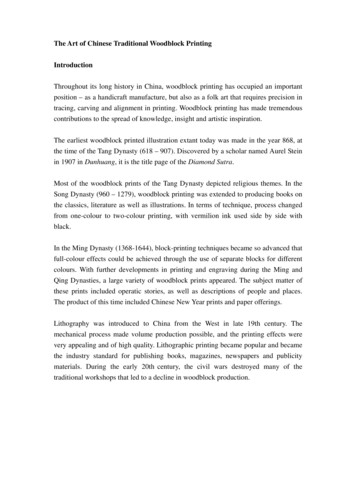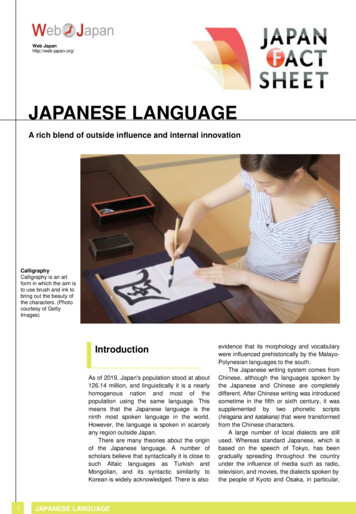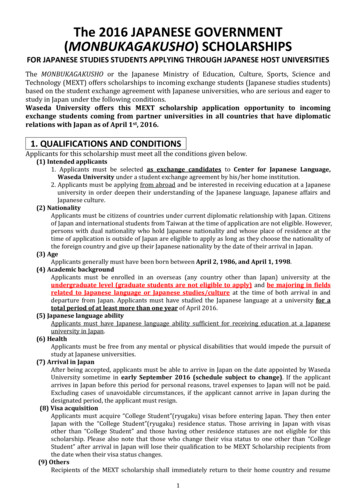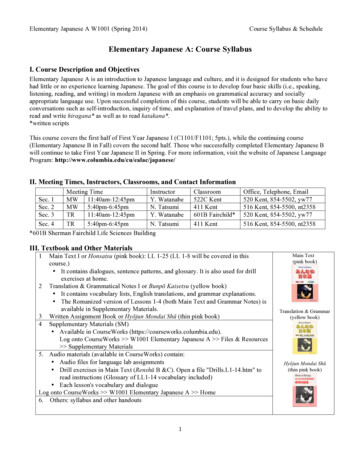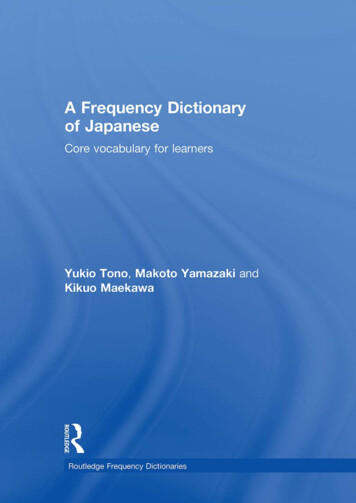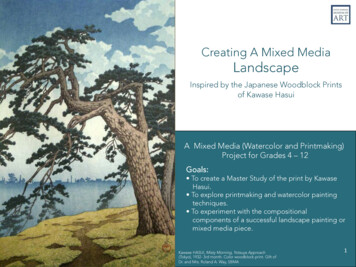
Transcription
Creating A Mixed MediaLandscapeInspired by the Japanese Woodblock Printsof Kawase HasuiA Mixed Media (Watercolor and Printmaking)Project for Grades 4 – 12Goals: To create a Master Study of the print by KawaseHasui. To explore printmaking and watercolor paintingtechniques. To experiment with the compositionalcomponents of a successful landscape painting ormixed media piece.Kawase HASUI, Misty Morning, Yotsuya Approach(Tokyo), 1932- 3rd month. Color woodblock print. Gift ofDr. and Mrs. Roland A. Way, SBMA1
Art & Artist: BackgroundKawase Hasui (May 18, 1883 – November 7, 1957) was a prominent Japanesepainter of the late 19th and early 20th centuries, and one of the chiefprintmakers in the shin-hanga movement. Hasui worked almost exclusively onlandscape and townscape prints based on sketches he made in Tokyo andthroughout the country. His prints feature tranquil locations that are oftenjuxtaposed with increased urbanized areas of Japan.Kawase HASUI, Misty Morning,Yotsuya Approach (Tokyo), 1932- 3rdmonth. Color woodblock print. Gift ofDr. and Mrs. Roland A. Way, SBMAThe shin–hanga (“new prints” or “new woodblock prints”) movementrevitalized traditional ukiyo-e art, and maintained the traditional ukiyo-esystem where the artist, carver, printer, and publisher engaged in acollaborative division of labor, as opposed to the sosaku-hanga (creativeprints) movement which advocated the principles of self-drawn, self-carved,and self-printed art, in which the artist, with the desire of expressing the self,is the sole creator of art.The movement flourished from around 1915 – 1942, though it resumed brieflyfrom 1946 through the 1950s. Inspired by European Impressionism, the artistsincorporated Western elements such as the effects of light and theexpression of individual moods, but focused on strictly traditional themes oflandscape, famous places, beautiful women, kabuki actors, and birds andflowers.Hasui left a large body of woodblock prints and watercolors. He and HiroshiYoshida are widely regarded as two of the greatest artists of the shin-hangastyle, and known especially for landscape prints.
As students view this image, ask them toconsider:How is the foreground distinguished frombackground?How has the artist “layered” the print—creating depth, dimension, andperspective?What are the atmospheric effects ofproximity and distance? How has theartist rendered these effects?How has the artist invited the viewer(compositionally) into the scene?Do you see evidence of urbanization?Where? What details can you cite?Kawase HASUI, Misty Morning, Yotsuya Approach(Tokyo), 1932- 3rd month. Color woodblock print. Gift ofDr. and Mrs. Roland A. Way, SBMA3
Features of Ukiyo-e ay lifeAsymmetryA strong subject, often from nature, located to theright or left of centerLandscape ElementsPositioned in the background, often silhouettedA Foreground DeviceLeads the viewer into the sceneKawase HASUI, Misty Morning, Yotsuya Approach(Tokyo), 1932- 3rd month. Color woodblock print. Gift ofDr. and Mrs. Roland A. Way, SBMACan you locate these features in this print?
THE ART LESSONIn this lesson sequence, students will complete two projects: a Master Study (mixed media piece) based on the print by Kawase Hasui an optional mixed-media landscape of the local environment, inspired by theartwork of Kawase Hasui.Materials for this lesson: Scratch-Art foam printing plates pencils watercolor paper permanent black pens (fine tipSharpies) watercolor paints watercolor brushes containers of water Masonite boards (for taping thewatercolor paper) painter’s masking tape (bluetape) paper towels soft brayers (optional) water soluble printing inks paint brushes for applyingprinting ink to the foam platesKawase HASUI, Misty Morning, Yotsuya Approach(Tokyo), 1932- 3rd month. Color woodblock print.Gift of Dr. and Mrs. Roland A. Way, SBMAPrototype by Itoko Maeno, SBMA Teaching Artist5
Beginning the Project:Tape a 9” x 12” piece of watercolor paper to a Masonite board(use painter’s tape).Invite students to look carefully at the background elements ofKawase Hasui’s print. Ask:Where is the horizon line located? What do you notice?(buildings that look as though they are part of an urbanlandscape)Direct students to draw the landscape elements of the city inthe distance (building shapes above the horizon line) using verylight pencil sketching. Then ask:What colors do you see in the sky?Students will notice that the sky directly above the horizon is avery pale shade of yellow-gold.Demonstrate how to mix this color by dropping a slight amountof brown pigment into a pool of yellow watercolor paint.Brush clear water onto the watercolor paper above the horizonline. Starting at the horizon line, drop the premixed soft goldpigment onto the damp watercolor paper. The gold pigmentshould disappear into clearness (no color) towards the top ofthe piece. Note: Turning the board upside down and allowingthe gold pigment to spread down the paper will ensure agraded, soft dispersion of paint. Allow the paper to drythoroughly.6
1526347Using the image of Kawase Hasui’s print as a reference, add blue watercolor pigment across the top thirdof the paper, leaving areas of dry paper for the clouds. Refer to slides 1-5.While the blue pigment is still damp, load the clean brush with clear water and lightly blend the bluepigment into the soft gold color described in the previous slide (slide 6). Brush the clear water all the wayto the horizon line to avoid visible line breaks between layers of paint application. Allow the paper to dry(slide 7).7
Next, students will add the skyline of the city and thebody of water, but first the paper must dry thoroughly.While waiting for the sky to dry, students can create thefoam plate for printing the tree and the land area in theforeground of the piece.Students trace over theouter contour lines of thetree and land details with ablack Sharpie pen. The inkwill bleed through the copypaper, and the drawn lineswill be visible on the reverseside of the paper. Note thecorner markings thatindicate the edges of theentire composition.8
1) Demonstrate how to position the traced imagedirectly over a Scratch Foam plate (a thin sheet offoam). Using a pencil, students should trace over thelines created by the Sharpie.12) The pressure of the pencil will create indentedlines in the foam sheet.3) Show students how to drawover the indented lines withinthe foam plate (using a pencil).This will create deeper groovesin the the foam plate and makethe lines more visible.234) When they finish, studentswill set their foam platesaside and continue paintingthe watercolor background(next slide).9
Demonstrate to students how to paintshaded (gray) shapes within the whitecloud areas.Next, paint a wide band of clear water under thepale gold area of the sky. This will be the horizonline of the water and the cityscape.10
Drop blue watercolor pigment into the clearwater and push the blue paint upward to createthe shapes of the buildings in the distance.Continue adding blue pigment across the page.Then paint additional wide bands of clear wateracross the paper until it reaches the bottom ofthe page. The blue paint will flow into the clearwater, creating a graded wash of color.11
Turn the paper, and drop in small amounts of pale bluewatercolor pigment across the bottom of the compositionarea.Lift the paper at an angle and allow the blue paint to dripdown the page into the (previously painted) horizon line/cityscape pigment.Let the entire watercolor scene dry completely.12
While the watercolor paper is drying, prepare palettes ofwashable printing ink (yellow, green, brown, blue, andblack).Demonstrate how to mix colors to achieve desired shades,and paint the printing ink onto the foam plate (the tree,leaves, and land in the foreground only). Work quickly toprevent the ink from drying.13
Continue painting until the tree and the land areas arecompletely filled in with ink.Demonstrate how to carefully turn the painted foam plate over,positioning it on top of the watercolor background. Gently press downon the plate.Rub evenly over the plate.14
Direct students to carefully lift the foam plate from thepaper, and admire their completed projects!Option: Before the residual paint on the plate is dry,roll black printing ink onto a brayer, and roll the inkedbrayer over the foam plate. Print onto a piece ofcolored paper to create an additional work of art.15
Applying techniques to a new project:Students can apply the same sequence anduse of techniques described in this MasterStudy to a mixed media project of a scene fromthe local landscape.Curriculum ConnectionThis art lesson reinforces student observationsand understandings of the features of differentgeographic regions within California.CA History/Social Science Standard 4.1:Students demonstrate an understanding of thephysical and human geographic features that defineplaces and regions in California.16
Connections to the StandardsFrom the National Visual Arts StandardsCreating / Conceiving and developing new artistic ideas and work.Anchor Standard #1. Generate and conceptualize artistic ideas and work.Anchor Standard #2. Organize and develop artistic ideas and work.Anchor Standard #3. Refine and complete artistic work.Grade 4VA:Cr2.1.4 Explore and invent art-making techniques and approaches.Grade 5VA:Cr2.1.5 Experiment and develop skills in multiple art-making techniques and approaches through practice.VA:Cr2.3.5 Identify, describe, and visually document places and/or objects of personal significance.Responding / Understanding and evaluating how the arts convey meaning.Anchor Standard #7. Perceive and analyze artistic work.Anchor Standard #8. Interpret intent and meaning in artistic work.Anchor Standard #9. Apply criteria to evaluate artistic work.Grade 4VA:Re8.1.4 Interpret art by referring to contextual information and analyzing relevant subject matter, characteristics of form, and use ofmedia.VA:Re9.1.4 Apply one set of criteria to evaluate more than one work of art.Grade 5VA:Re8.1.5 Interpret art by analyzing characteristics of form and structure, contextual information, subject matter, visual elements, anduse of media to identify ideas and mood conveyed.Grade 5VA:Re9.1.5 Recognize differences in criteria used to evaluate works of art depending on styles, genres, and media as well as historicaland cultural contexts.Grades 6 – 8VA:Re8.1.8aInterpret art by distinguishing between relevant and non-relevant contextual information and analyzing subject matter,characteristics of form and structure, and use of media to identify ideas and mood conveyed.HSVA:Re9.1.IIIa Construct evaluations of a work of art or collection of works based on differing sets of criteria.Connecting / Relating artistic ideas and work with personal meaning and external context.Anchor Standard #10. Synthesize and relate knowledge and personal experiences to make art.Grade 5VA:Cn10.1.5aApply formal and conceptual vocabularies of art and design to view surroundings in new ways through art- making.HSVA:Cn10.1.Ia Document the process of developing ideas from early stages to fully elaborated ideas.17
This lesson was created by Joni Chancer, SBMA Curriculum Consultant.Credits and permissions:This presentation was created by SBMA for instructional use only and is not to be altered inany way, or reproduced without attribution.Artwork was created by SBMA Teaching Artists.For further information about these or other Education and Outreach Programs, contactRachel Krieps at rkrieps@sbma.net18
To explore printmaking and watercolor painting techniques. To experiment with the compositional components of a successful landscape painting or mixed media piece. 1 A Mixed Media (Watercolor and Printmaking) Project for Grades 4 - 12 Kawase HASUI, Misty Morning, Yotsuya Approach (Tokyo), 1932- 3rd month. Color woodblock print. Gift of


